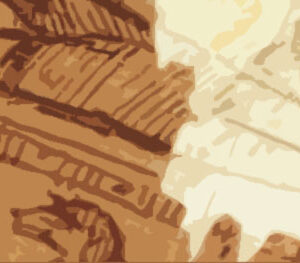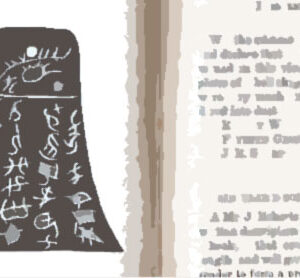Facsimile 3 is described by Joseph Smith as
“Abraham sitting upon Pharaoh’s throne, by the politeness of the king, with a crown upon his head, representing the Priesthood, as emblematical of the grand Presidency in Heaven; with the scepter of justice and judgment in his hand.”

Once again, this is not about Abraham at all, but is about Hor. And we don’t need the original to show this, since Joseph Smith included the hieroglyphics right in the Facsimile this time.

And that’s not all, there are plenty of other hieroglyphics in this one. What’s more is that Joseph specifies what the hieroglyphics mean. This is a rare occurrence that Joseph Smith published something where he provided both the source and the translation.
Below I have circled the sections that Joseph Smith attempted to translate, with the translated parts color-coordinated in the “Explanation” section (which is included in the Book of Abraham). Make sure and match the colored words below with the circle of the same color in Facsimile 3:

Joseph’s Explanation (from the PoGP):
- Abraham sitting upon Pharaoh’s throne, by the politeness of the king, with a crown upon his head, representing the Priesthood, as emblematical of the grand Presidency in Heaven; with the scepter of justice and judgment in his hand.
- King Pharaoh, whose name is given in the characters above his head. [look in the red circle above]
- Signifies Abraham in Egypt as given also in Figure 10 of Facsimile No. 1.
- Prince of Pharaoh, King of Egypt, as written above the hand. [look in the green circle above]
- Shulem, one of the king’s principal waiters, as represented by the characters above his hand. [look in the blue circle above]
- Olimlah, a slave belonging to the prince.
Let’s look at what Egyptologists all confirm as the translation compared to Joseph Smith’s translations and interpretations:
| Joseph Smith’s Explanation in the Pearl of Great Price | Explanation by Egyptologists (quotes are from Robert K. Ritner) | |
| General Comment | Abraham is reasoning upon the principles of Astronomy, in the king’s court. | “Invocation (text at bottom line below the illustration): O gods of the necropolis, gods of the caverns, gods of the south, north, west, and east grant salvation to the Osiris Hor, the justified, born by Taikhibit.” |
| Fig. 1 | Abraham sitting upon Pharaoh’s throne, by the politeness of the king, with a crown upon his head, representing the Priesthood, as emblematical of the grand Presidency in Heaven; with the scepter of justice and judgment in his hand. | “Label for Osiris (text to the right of figure 1 of facsimile 3): Recitation by Osiris, Foremost of the Westerners, Lord of Abydos(?), the great god forever and ever(?).” |
| Fig. 2 | King Pharaoh, whose name is given in the characters above his head. | “Label for Isis (text to the right of figure 2 of facsimile 3): Isis the great, the god’s mother.” |
| Fig. 3 | Signifies Abraham in Egypt as given also in Figure 10 of Facsimile No. 1. | “Altar, with the offering of the deceased, surrounded with lotus flowers, signifying the offering of the defunct.” –Theodule Deveria |
| Fig. 4 | Prince of Pharaoh, King of Egypt, as written above the hand. | “Label for Maat (text to the left of figure 4 of facsimile 3): Maat, mistress of the gods.” |
| Fig. 5 | Shulem, one of the king’s principal waiters, as represented by the characters above his hand. | “Label for Hor the deceased (text in front of figure 5 of facsimile 3): The Osiris Hor, justified forever.” |
| Fig. 6 | Olimlah, a slave belonging to the prince. | “Label for Anubis (text in front of figure 6 of facsimile 3): Recitation by Anubis, who makes protection(?), foremost of the embalming booth,…” |
I can understand having names differ, but the translations are not remotely similar in content or meaning. He thought Isis (a woman) was King Pharoah, Maat (another woman) was the Prince of Pharaoh, and Anubis was a slave (being black).
Let’s focus on Anubis, since it was previously established that he should have a jackal head. Keep in mind that we definitely know that this should be Anubis since it says it right above his head “Label for Anubis”. Why it doesn’t exactly look like Anubis we can only speculate since we don’t have the original.
In Joseph Smith’s day, as you know, they didn’t have copying machines. What we have for Facsimile 3 is a trace of what the actual papyrus had. Judging the problems with sections being missing or hard to read for Facsimile 1 and 2, we can speculate that the source for Facsimile 3 was similarly difficult to make out. Besides the fact that they are both black, the most interesting clue we can draw from this poor representation of Anubis is the spike on the his head in Joseph Smith’s attempt to draw him. This is most likely a remnant of Anubis’ pointy ears.

Like I pointed out in the first two facsimiles, the first is a common embalming scene depicting Anubis, and the second is a hypocephalus. What about this one? It is simply a depiction of the judgment hall scene in the Egyptian afterlife doctrine. Here is just one example from the book of the dead of Hunefer, 19th dynasty:

Let’s compare those left two figures with the ones in Facsimile 3:

A match! And who are they? Just as the hieroglyphics indicate just above them in both depictions: these are Isis and Osiris, not King Pharaoh and Abraham.
Questions:
- If Joseph Smith was a prophet, why wasn’t he able to accurately translate the hieroglyphics?
- Even if he couldn’t read the hieroglyphics, why didn’t the Spirit tell him who the characters in this scene were?
- If he was being inspired to fill in the missing sections, why didn’t he accurately portray Anubis?
The actual text of the Book of Abraham
Since Joseph’s interpretations of the facsimiles are demonstrably incorrect, it would make sense that the actual text in the Book of Abraham would be made up as well. I would like to demonstrate that in this section.
As Joseph was “translating” the papyri, he documented the translation as a glossary in what is now known as the Kirtland Egyptian Papers as I mentioned earlier (which I will call “KEP” from now on). If there’s any question if it was Joseph who was in charge of these papers (even if he wasn’t the scribe), he even kept track in his own journal that he was making this glossary:
“The remainder of this month, I was continually engaged in translating an alphabet to the Book of Abraham, and arranging a grammar of the Egyptian language as practiced by the ancients.” (History of the Church 2:238)
The KEP are owned by the LDS Church and kept secretly in their vault, but a microfilm copy of them was leaked to the Tanner Lighthouse Ministries. You will soon see why the Church did not want anyone to see these papers.
Here, for example, is page 3 from the KEP:

If you look closely, you’ll see that in the margin on the left are Egyptian characters and to the right are their translations according to Joseph (which are also found in the Book of Abraham). When we look at these characters in the margins on this page and subsequent pages, we can easily find them in the original papyrus found in 1966:

Here is page 3 from the KEP, along with the corresponding characters in the papyrus:

You’ll notice that he is looking at the papyrus and taking the characters from the top left of the characters just to the left of what we now know as Facsimile 1, copying them into the KEP, and indicating his proposed translation. The words in his translation on this page, for example, match up with Abraham 1:11–19.
You’ll also notice that his translations are whole paragraphs for single characters. This was a common assumption of Joseph’s day that each hieroglyphic stood for many words in English. The Rosetta Stone wasn’t translated into English until 1858. Now we know that each hieroglyphic usually stands for just a single word in English.
Joseph’s translations are wrong. Here is an example below of his faulty translations from the page above:
| Symbol Number | From Papyrus | From KEP | Actual Translation | Joseph’s Attempted Translation in the KEP / Book of Abraham |
| 1 |  * * |
 * * |
“pool” | “manner of the Egyptians. And it came to pass that the priests laid violence upon me, that they might slay me also, as they did those virgins upon this altar; and that you may have a knowledge of this altar, I will refer you to the representation at the commencement of this record.” (KEP page 3, paragraph 1 / Abraham 1:11–12) |
| 2 |  * * |
 * * |
“water” | “It was made after the form of a bedstead, such as was had among the Chaldeans, and it stood before the gods of Elkenah, Libnah, Mahmackrah, Korash, and also a god like unto that of Pharaoh, king of Egypt. That you may have an understanding of these gods, I have given you the fashion of them in the figures at the beginning, which manner of the figures is called by the Chaldeans Rahleenos, which signifies hieroglyphics.” (KEP page 3, paragraph 2 / Abraham 1:13–14) |
| 3 |  * * |
 * * |
“great” | “And as they lifted up their hands upon me, that they might offer me up and take away my life, behold, I lifted up my voice unto my God, and the Lord hearkened and heard, and he filled me with the vision of the Almighty, and the angel of his presence stood by me, and immediately unloosed my bands;” (KEP page 3, paragraph 3 / Abraham 1:15) |
| 4 |  * * |
 * * |
“Khonsu” (Egyptian moon god) | “And his voice was unto me: Abraham, Abraham behold, my name is Jehovah, and I have heard thee, and have come down to deliver thee, and to take thee away from thy father’s house, and from all the kinsfolk, into a strange land which thou knowest not of; And this because they have turned their hearts away from me, to worship the god of Elkenah, and the god of Libnah, and the god of Mahmackrah, and the god of Korash, and the god of Pharaoh, king of Egypt; therefore I have come down to destroy him who hath lifted up his hand against thee, Abraham, my son, to take away thy life. Behold, I will lead thee by my hand, and I will take thee, to put upon thee my name, even the Priesthood of thy father, and my power shall be over thee. And it was with Noah so shall it be with thee; but through thy ministry my name shall be known in the earth forever, for I am thy God.” (KEP page 3, paragraph 4 / Abraham 1:16–19) |
Final thoughts
There are a lot more details involved here that I didn’t touch on simply to avoid making this essay any longer than it needs to be.
Facsimiles similar to 1, 2, and 3 are standard burial documents, not about Abraham. The text of the papyrus is not about Abraham either. The papers and facsimiles have been translated by egyptologists, and we know they are not what Joseph claimed. I believe this calls into question his ability to translate anything correctly, such as the Book of Mormon.




Hello have you seen the evidence that the ‘slave” Anubis dogface has been chisled out in the printing plate for the Times and Seasons? https://book-of-abraham-facsimile-no‑3.my-free.website/